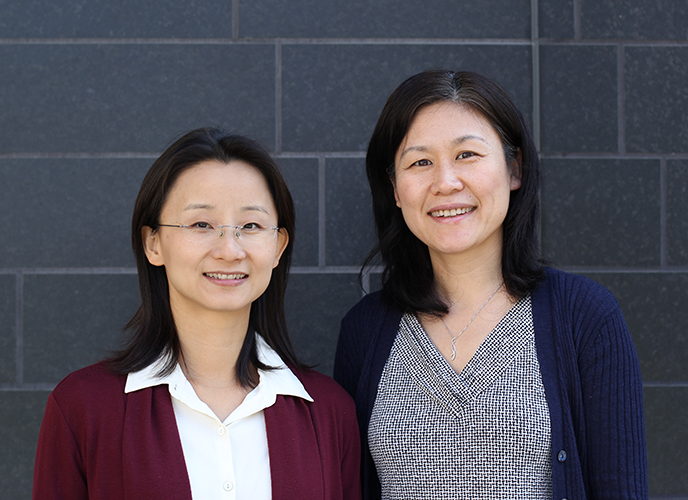
Principal investigators Min Yu, MD, PhD, and Rong Lu, PhD, had plans to collaborate long before they were both recruited to the Department of Stem Cell Biology and Regenerative Medicine at the Keck School of Medicine of USC.
Yu, recruited in conjunction with the USC Norris Comprehensive Cancer Center, focuses on breast cancer, filtering out circulating tumor stem cells from the blood to understand how the disease spreads and stop it in its tracks. Lu studies what makes one blood stem cell outcompete or coordinate with another, which has ramifications for improving transplants and preventing cancers.
They first met when they were postdoctoral scholars on opposite coasts: Lu at Stanford University and Yu at Massachusetts General Hospital (MGH) of Harvard Medical School. Lu took a trip east to give a seminar at MGH, which Yu attended.
“After my talk, Min came up to me and introduced herself, and we discussed a little bit about the possibility of collaborating,” said Lu. “We didn’t know we’d end up within the same research center. It is a wonderful surprise.”
Yu shares the sentiment. “What a small world!” she said. “I’m very excited to actually collaborate with Rong, and I couldn’t imagine we would end up in the same research center.”
Yu grew up in northeast China’s Shandong Province in the coastal city of Qingdao, famous for its beer. She had a strong interest in computer science, but her mother encouraged her to follow in her footsteps and become a physician.
Yu earned her MD at Shandong Medical University and her master’s degree in neurology at Peking University Health Science Center.
“Neurology is a very sad field, because there are a lot of genetically inherited diseases that just really have no treatment,” she said. “There’s only so much a doctor can do.”
Determined to find new treatments as a researcher, Yu joined the PhD program at SUNY Stony Brook University/ Cold Spring Harbor Laboratory, where she developed an interest in breast cancer. She did her postdoctoral work at MGH in the lab of Daniel A. Haber, MD, PhD, who was collaborating with clinicians and bioengineers to study circulating tumor cells, which enter the bloodstream and metastasize at distant sites.
“During that time, I lost my dad, because my dad had liver cancer,” said Yu. “So that made it clear to me that we need to bridge the basic research to the clinical. That’s something very, very important.”
After her father’s death, Yu took up running and completed four marathons in two years. “Min means ‘quick and smart,’ so I like to brag as if my name turned out to be true,” joked Yu, who also enjoys hiking and camping with her husband.
Lu grew up in northeast China’s Liaoning Province in Liaohua, a town with a government-run petrol oil factory where both of her parents worked.
“When the Cultural Revolution happened, my parents were in primary school, so they didn’t even get a chance to go to middle school,” said Lu. “It’s an unfortunate generation that didn’t get the education they deserved, and didn’t have the chance to choose what they wanted to do.”
When the time came for Lu to attend college, she considered her mother’s unrealized ambition to be a doctor and her father’s gifts as a traditional Chinese ink painter.
“I’m a combination between my mom and my dad,” said Lu, whose artistic talents include playing the piano and the pipa, a four-stringed Chinese lute, and painting with oils and Chinese inks. “I thought biology was a good combination of what I wanted to explore — fulfilling my scientific curiosity and learning more about the unknown. I felt it also had something to do with medicine and helping people, which satisfied my mom’s expectation.”
She earned her bachelor’s degree from Lanzhou University, spent a year in Beijing studying English and entered the PhD program at Princeton University, where she studied gene expression in embryonic stem cells. At Princeton, she also met her husband, a physicist who was studying neuroscience with goldfish in the department next door.
As a postdoctoral scholar in the lab of Irving Weissman, MD, at Stanford University, Lu came up with the idea of “barcoding” individual blood stem cells by labeling them with a genetic marker. This allowed her to observe individual cells’ behavior, interactions, self-renewal or differentiation, and contributions to forming blood. The same approach applies to tracking and understanding the behavior of cancer cells in collaboration with Yu and other colleagues across the university.
“The most important reason I came to USC is the people here,” said Lu. “The stem cell department is growing, and everybody’s having new ideas and really being interactive and collaborative. You can feel the energy here.”
This dynamic, multidisciplinary research environment also attracted Yu. “Our director Andy McMahon has a vision of uniting the bioengineering and medical fields, and applying basic science to clinical science,” she said. “He’s very passionate about helping young faculty start their labs and set up collaborations, so I’m excited to join.”
